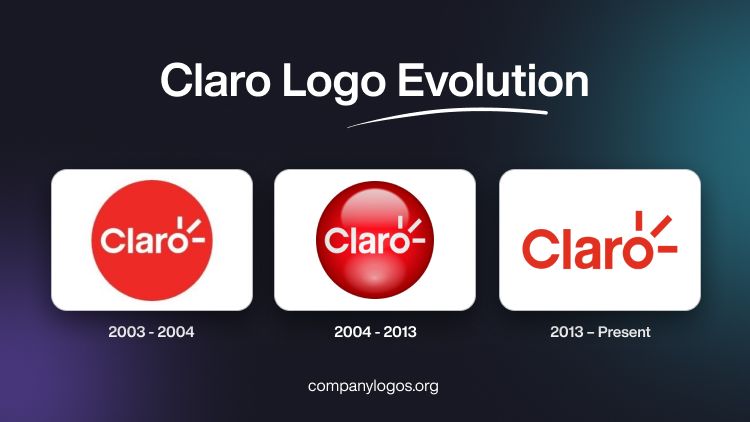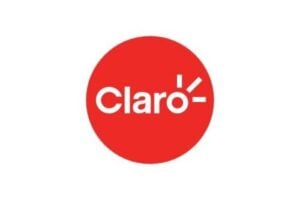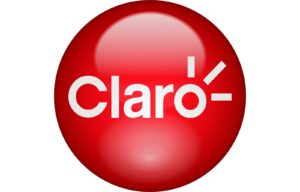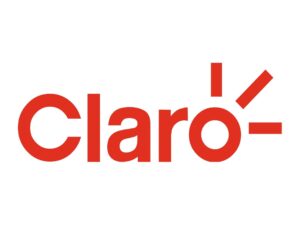
Claro is a leading telecommunications company in Latin America that operates under the umbrella of América Móvil, the Mexican telecom giant founded by Carlos Slim. The company offers a range of services, such as mobile, broadband, and television across the region. It has a presence in countries such as Brazil, Argentina, Chile, Colombia, and many more. The logo of Claro has become synonymous with mobile connectivity and innovation, but its visual identity has undergone a few changes since the brand’s inception. The article delves into the logo changes made by Claro, among other details of the company.
The Genesis of the Claro Logo (2003 – 2004)
The first Claro logo displayed the brand name in white title case inside a bright red circle. The letter “o” in the brand name had three rays in white emanating from it to symbolise waves, brightness, and communication that established the mobile connection. The red colour of the circle is vibrant and energetic, while the white text inside the circle ensures high contrast and legibility. This design has remained largely consistent since its adoption.

(2004 – 2013)
This iteration was a continuation of the original logo design, but with the addition of a gradient, shades, and highlights. These gave the logo an overall three-dimensional look. Besides, the brightness of the logo was reduced.

(2013 – Present)
The current Claro logo does not have the red circle but only the brand name in red against a white background. This design devoid of the outer circle has ensured the logo looks cleaner and minimalist.

The Elements of the Claro Logo
Font
The wordmark representing the Claro logo is rendered in a bold red colour using a sans-serif typeface with soft, rounded lines.
Colour
The Claro logo is depicted in a vibrant red colour palette to symbolise passion, determination, and the drive shown by the company to lead in technology.
The History of Claro
Claro was established in Brazil in 2003 through the merger of several América Móvil-owned operators, namely, ATL, BCP, Americel, Tess Celular, and Claro Digital. This consolidation marked the beginning of Claro as a unified brand, which enabled América Móvil to streamline its operations and branding strategy in Brazil, the largest market in Latin America. Claro quickly expanded its service footprint to additional Brazilian states, including Bahia, Sergipe, Santa Catarina, Paraná, and Minas Gerais.
After its success in Brazil, Claro began expanding across Latin America. The brand made its first foray outside national borders in the early 2000s and entered neighbouring countries and gradually replaced local brands with the Claro name. In 2006, Claro launched operations in El Salvador, Honduras, and Nicaragua by rebranding existing services and acquiring local operators to strengthen its presence. That same year, Claro entered the Chilean market after acquiring Smartcom PCS and rebranding it as Claro Chile.
In Argentina, Paraguay, and Uruguay, Claro was launched on March 25, 2008, as a rebranding of CTI Móvil. This way, it further consolidated the regional assets of América Móvil under a single, recognisable identity. In Guatemala, Claro replaced Telgua’s PCS Digital and Alo de PCS brands in 2006.
Claro has consistently invested in expanding its range of services. These include mobile telephony, landline, broadband internet, and satellite television. Over the years, the company has adopted and introduced new technologies, such as GSM, CDMA, UMTS/HSDPA, and, more recently, 4G and 5G networks. In Brazil, Claro was among the first operators to introduce the iPhone 3G and has continued to innovate with offerings like Internet Móvel 5G+ for residential customers.
Today, Claro is headquartered in Mexico City and São Paulo, with more than 100,000 employees and subsidiaries like Embratel and Claro Guatemala. It is one of the largest mobile operators in Latin America, with over 260 million active connections as of 2012. It has a mobile penetration rate exceeding 130% in some markets. Claro ranks third in the mobile operator market in several countries, and it trails only major competitors like Movistar and Entel.
The name “Claro” means “bright”, “clear”, or “of course” in both Portuguese and Spanish and reflects the company’s commitment to clarity and connectivity. The brand is widely recognised for its bold red logo and consistent marketing across the region.
Claro continues to expand and modernise its network infrastructure. In recent years, it has incorporated companies like Embratel and NET in Brazil, launched advanced 5G services, and signed strategic partnerships to improve connectivity in remote regions such as the Amazon. The company remains a key player in Latin America’s digital transformation and delivers innovative telecom solutions to millions.
Interesting Facts About Claro
- Claro is a subsidiary of América Móvil, the Mexican telecommunications giant founded by Carlos Slim. It is one of the largest telecom companies in the world.
- Claro operates in 18 countries across the Americas and 7 countries in Europe. This makes it the largest telecommunications company worldwide in terms of total access lines and the second largest in mobile subscribers (excluding China and India).
- In both Portuguese and Spanish, “Claro” means “bright”, “clear”, and “of course”, thus reflecting the brand’s commitment to clarity and connectivity.
- Claro was established in Brazil in 2003 through the merger of several América Móvil-owned operators. These included ATL, BCP, Americel, Tess Celular, and Claro Digital.
- The brand was launched in Argentina, Paraguay, and Uruguay on March 25, 2008, as a rebranding of CTI Móvil. In El Salvador, Honduras, and Nicaragua, Claro entered the market in September 2006.
- Claro offers a wide array of services, which include mobile, fixed-line, broadband internet, TV, and even Internet of Things (IoT) solutions.
- Claro ranks third in the mobile operator market in many countries, and it trails only behind Movistar and Entel.
- Claro is known for its effective and widespread marketing campaigns. These target a broad demographic, from young urban social groups to seniors, and use taglines like “Yo soy Claro, y me gusto.”
- Its subsidiaries include Embratel and Claro Guatemala, and its brand extensions reach into media and entertainment with services like Claro Sports, Claro Music, and Claro Video.
- The company employs over 100,000 people globally and has invested heavily in training and development to maintain a highly qualified workforce.
- Claro has been at the forefront of introducing new technologies in Latin America, such as early adoption of GSM, CDMA, UMTS/HSDPA, and 4G/5G networks.
- Claro’s red-and-white branding is highly visible in urban landscapes across Latin America. It is often featured on prominent billboards and city landmarks.
- Claro boasts high customer satisfaction and strong brand equity, thanks to its reliable service and extensive distribution network.
Finally
The Claro logo and its various iterations show the growth journey of the company from a collection of regional telecom providers to a unified, pan-Latin American brand. The transition from a simple wordmark to the dynamic red sphere reflects Claro’s commitment to innovation, clarity, and connectivity. Today, the Claro logo is instantly recognisable and stands as a symbol of reliable communication for millions across the Americas.